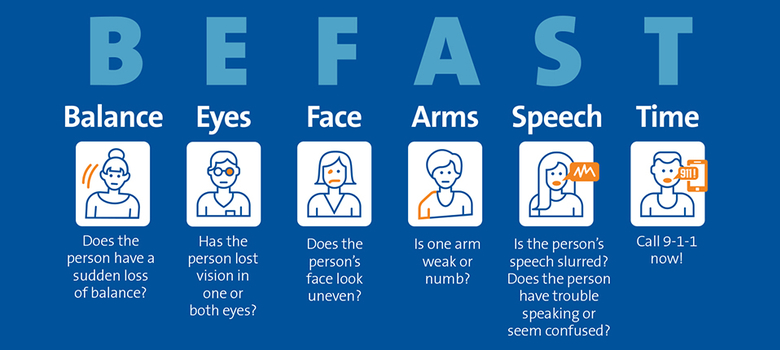I’m glad I knew the warning signs of a stroke.
“Take care of your body. It’s the only place you have to live.”
– John Rohn
You always think it can’t happen to you. Walking daily, practicing yoga, and eating plenty of fruits and fresh vegetables, you believe you’ve checked off all the boxes for good health.
Until one day, you experience unusual vertigo, and your blood pressure rises to a crisis level. Then, your right side begins to tingle and go numb.
Your body just sent warning signs, and they demand immediate attention, now. A stroke can happen at any age—to anyone. The silent killer, cardiovascular disease, can lurk in the background as we continue to eat fast food, smoke, or drink excessively. Or, in some cases, even when you think you’ve done everything right.
Stroke is the fifth leading cause of death and disability in the United States. The good news — you can prevent a stroke, and you can survive a stroke. But you must act quickly at the first warning signs.
Stroke Survivors
“Our greatest glory is not in never falling, but in getting up every time we fall.”
– Confucius
Did you know that someone has a stroke every 40 seconds?
Lillian, Prince, Brooke, and Clark never expected or anticipated a stroke. With different circumstances and lifestyles, they all share one life-saving response. The people around them, family or friends, knew the warning signs of a stroke and acted quickly.
Lillian knew something was wrong and called her husband who took her to the hospital only three blocks away. Lillian was 46 years old, under stress in her job, and 20 pounds overweight. Her doctor told her that walking 30 minutes a day could make a difference. She now keeps her blood pressure under control and jogs regularly to stay healthy.
While playing basketball with his friends, Prince lost his balance. His friends recognized the early warning signs of a stroke. At 39, Prince didn’t take care of his health and didn’t know that he had uncontrolled high blood pressure. He now eats more fruits and vegetables and monitors his blood pressure.
Brooke attributed the weakness in her arm to carrying her newborn, but her Mom noticed her drooping face. After the birth of her first child at 29, Brooke suffered a stroke and underwent a thrombectomy to remove the blood clot doctors believed originated in the arteries of her neck. She speaks out to educate others on the warning signs that can save lives.
Clark’s wife noticed something wrong when his speech began to slur. Clark ate healthily, but a family history of high blood pressure and high cholesterol may have contributed to his ischemic stroke in 2013. Prior to his stroke, Clark had a physically strenuous job and considered himself a regular gym rat. He is still working to regain the use of his right arm, walks with a limp, and struggles with aphasia, a language disorder affecting his speech.
Know the Warning Signs
By knowing the acronym BE FAST, you could save the life of a friend, a loved one—or your own.

The American Stroke Association suggests everyone know the early warning signs, FAST. Watch for one side of the face drooping. Check for weakness in the arms. Listen for any signs of slurred speech, or the inability to speak. Time is critical in addressing the effects of a stroke. Call 9-1-1. Don’t wait because the sooner you receive medical intervention the more likely you will recover.
Some medical groups now include BE to remind us about two other common signs, dizziness causing a loss of balance or loss of vision in one or both eyes.
Other Warning Signs
- Sudden NUMBNESS or weakness of the face, arm, or leg, especially on one side of the body
- Sudden CONFUSION, trouble speaking or understanding speech
- Sudden SEVERE HEADACHE with no known cause
What Is a Stroke?
A stroke occurs when a blood vessel that carries oxygen and nutrients to the brain is either blocked by a clot or bursts (or ruptures). When that happens, part of the brain cannot get the blood (and oxygen) it needs, so it and brain cells die.
—American Stroke Association
A stroke can occur from a clot obstructing the flow of blood to the brain (called an ischemic stroke). A hemorrhagic stroke results when a blood vessel ruptures and prevents blood flow to the brain. The third type of stroke or “mini-stroke” can cause a TIA (transient ischemic attack) caused by a temporary blockage in the brain.
Stroke Prevention
If you have a stroke, your chances of a second stroke increases unless you take steps to change your lifestyle. Remember that you can prevent strokes that can occur at any age. If you are in your twenties or thirties, don’t lull yourself into thinking it could never happen to you.
Follow these eight steps to prevent a second stroke or to avoid a stroke in your future.
1. Monitor your blood pressure
2. Control your cholesterol
3. Keep your blood sugar down
4. Remain active
5. Eat better
6. Lose weight if you need to
7. Don’t smoke, period.
8. Talk to your doctor about lifestyle changes or medication, if necessary
Personal Thoughts
No one ever expects or plans on a stroke. The signs come on quickly. My family history includes high blood pressure, type 2 diabetes, and stroke. I dismissed those markers because I believed I was healthy and could rise above any genetic tendencies.
Experiencing a TIA left me struggling to understand why my 10,000 steps a day, cycling, and healthy eating didn’t prevent this event. I was fortunate that my cardiovascular accident, as the doctors refer to it, left no permanent damage. As the neurologist put it, “You had a yellow flag, a slap on the wrist. Pay attention.”
I should be thankful. I am thankful, but I couldn’t shake this feeling of disappointment in my body, in myself. That sounds crazy as I write the words. My perfectionist tendencies came for a visit, I invited them in, and I fell into their trap.
Then, I received Selma’s newsletter. Actually, I didn’t read it until two weeks later. The universe conspired for me to receive her words when I was ready to hear them. I needed the encouragement to accept the warning and live in gratitude to be and become my healthiest—ever.
“Find your anchor and pivot. Trust on the ambiguity of tomorrow and know that if you are everything you can be in every moment, the ambiguity of the future will not be as frightful as it sounds.”
– Selma
Thanks, Selma. I have found my anchor—belief in myself and my strength. With a loving husband, children, grandchildren, and friends—I can face anything.`
“In order to love who you are, you cannot hate the experiences that shaped you.”
–Andréa Dykstra
And always—
Be kind. Be brave. Be you.
Photo: Pixabay



Leave A Comment